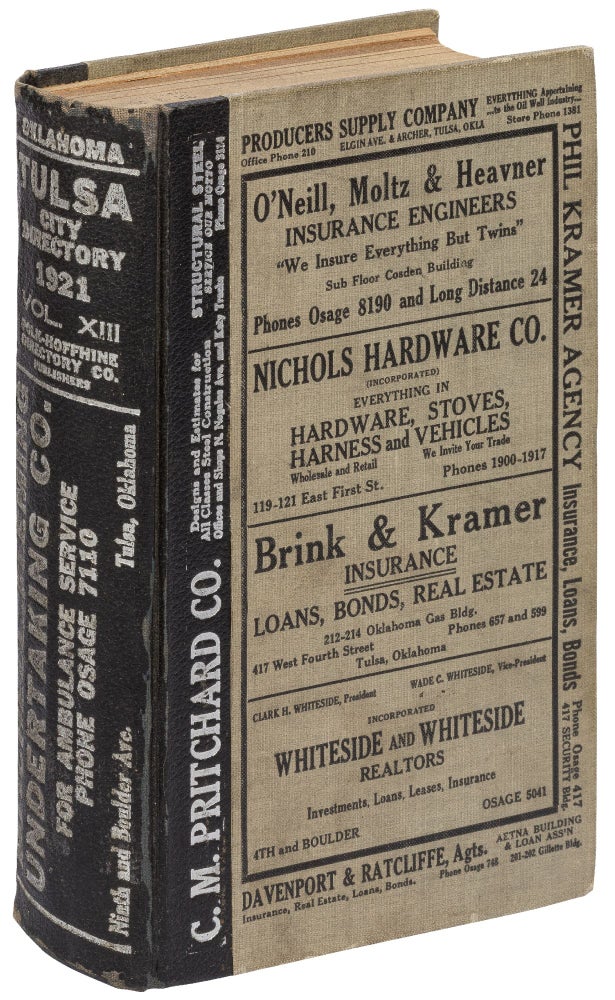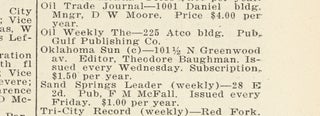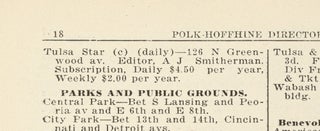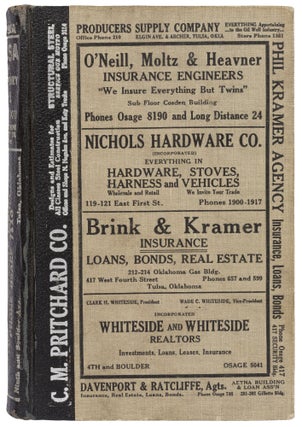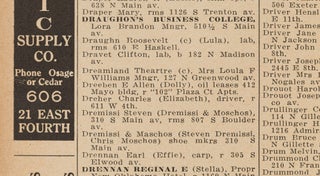Tulsa: Polk-Hoffhine Directory Co., 1921.
Sold
Hardcover. Tall, thick octavo. [10],11-830pp., plus three advertisement leaves. Original half black leather and printed gray cloth boards, title and advertisements printed in silver on the leather. Minor edge wear, spine ends and corners lightly rubbed. Ex-Sutro Library, with bookplate on front pastedown and ink stamp on first three leaves, minor toning to some gatherings. Overall very good, and a fresh copy, better than usually seen for directories of this kind.
A rare and historically important directory which includes the residents and businesses affected by the Tulsa Race Riots which erupted in the city around Memorial Day, 1921. Most of the directory is comprised of an alphabetical listing of residents and businesses, followed by a street and avenue directory, and a "Classified Business Directory and Buyer's Guide" organized alphabetically by business type. The businesses included here range from "Abstracts of Department Leases" to "Zinc Engineers," with a substantial section on oil producers.
Advertisements for local businesses are peppered throughout the text, and three leaves of full-page advertisements are inserted randomly within the text. As usual in directories, the advertisers run the gamut, including accountants, banks, doctors, electric companies, florists, funeral services, insurance agents, lawyers, plumbers, and more. The present directory also contains a high concentration of businesses relating to the energy business, as Oklahoma was awash in oil and natural gas at this time. The business directory includes nine pages of listings for oil and gas companies, petroleum engineers, oil field map producers, pipe and oil well suppliers, refineries, oil leasing companies, and other industry actors.
Most importantly, the directory records the names and locations of the businesses located in the Greenwood District of Tulsa, the most heavily-damaged area of the city during the Tulsa Race Riots (also known as the Tulsa Race Massacre and the "Black Wall Street Massacre"). About 11,000 African Americans lived in Tulsa in 1921, and they owned almost 200 businesses, mostly in northern Tulsa. The African-American section of north Tulsa was so prosperous it earned the nickname "Black Wall Street" and the "Negro Wall Street," the latter moniker bestowed on the area by no less than Booker T. Washington himself.
Numerous residents and businesses of the Greenwood section of Tulsa are recorded here, most no doubt affected by the conflagration in 1921. The directory includes three pages listing businesses and residents along Greenwood Avenue alone, with most entries followed by "(c)" indicating presumably that a "colored" person lives or works there. Dr. Andrew C. Jackson is listed here. He lived at 503 Greenwood Avenue until he ran out of his burning house with his hands in the air and was gunned down in his front yard. The Greenwood businesses include grocers, restaurants, barber shops, tailors, pharmacists, and more. Most, if not all of the businesses listed here were burned down on or shortly after June 1, 1921, including the Williams Building, the Elliott & Hooker laundry, and two African-American-owned newspapers the *Oklahoma Sun* and *Tulsa Star*. The latter newspaper was owned and published by Andrew Jackson Smitherman (whose residence is also listed here on Greenwood Avenue), who was forced to flee Tulsa after the race riots. Some white residents blamed Smitherman and the *Tulsa Star* for helping to incite the riots, and destroyed both Smitherman's home and the *Star* building at 126 Greenwood Avenue. The Dixie Theatre, a white-owned venue at 120 Greenwood is listed here; it was burned to the ground during the Black Wall Street Massacre. The Dreamland Theater, where many African-American residents of Tulsa gathered during the riots to develop an action plan, is listed here at 127 Greenwood; it was also destroyed on June 1, 1921, presumably along with all or most other businesses and houses listed in this section.
Exactly how many African Americans were killed in the Tulsa Race Riots is unknown, but modern projections estimate around 300 people. Many were buried in mass graves, loaded onto trains, or unceremoniously dumped into the Arkansas River. Additionally, hundreds of black-owned businesses and homes were destroyed by fire, and Tulsa was never the same again. The tragedy in Tulsa in 1921 is still a radically under-acknowledged, under-reported, and under-studied event in American history. The present directory helps to preserve the history of Tulsa, most notably of its African-American community, from just before the most tragic event in its history. For many of those involved in the Tulsa Race Riots, this directory is likely the last record of their presence in the city. .
Item #444569


